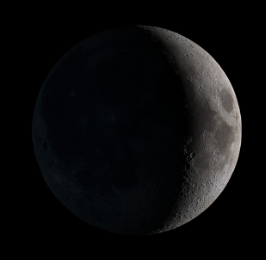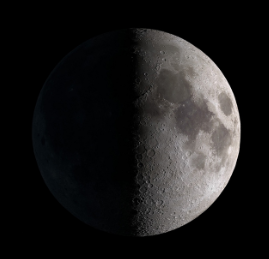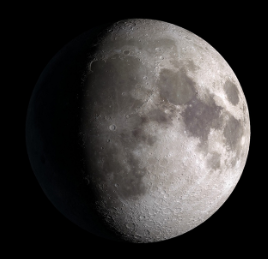- 701 W US-90, Marathon, TX 79842
- Marathon Sky Park
Best Nights/Moon Phases
The Moon’s waxing & waning phases affects our seeing during the nighttime. The higher percentage of luminance, the less that one can see faint objects in the nighttime sky through a telescope or a binocular. To understand the best nights to observe faint objects in the nighttime sky, one needs first to understand the Moon’s eight individual phases. Several animations follow toward the bottom of this page.
Find the night of the New Moon phase and that is the best night to visit Dark Texas Skies star party. During the night, the Moon is not visible at all because it sets in close approximation to the Sun. So both the Sun and Moon are never visible during the night after sunset.
The waxing crescent Moon phase begins when it becomes visible after the New Moon. Its illuminance begins to gradually increase from 0.1% to 49.9%. Fainter objects are still clearly visible between the first night of the waxing crescent Moon until the third night. We begin our star parties a little before sunset to take advantage of looking at it before the darkness overtakes us and the Moon appears too bright to view.
During the night of the First Quarter Moon, the Sun illuminates exactly 50% of the Moon’s surface from our viewpoint on Earth. The Moon’s position remains high in the night sky because it rises around noon and sets around midnight. Thus, its illumination washes out the fainter objects, such as fainter galaxies, open clusters and nebulae. All star parties are suspended from one night before First Quarter until the second or third night after the Full Moon.
The term “gibbous” means that the illuminated part of the Moon is greater than a semicircle and less than a circle. Every night, the Moon becomes more brilliant and sets later at night. As the waxing gibbous Moon moves toward the full Moon, only the brightest celestial objects can be seen through a telescope or binoculars. Therefore, all star parties are suspended one night before First Quarter until the second or third night after the Full Moon.
The Full Moon is opposite of the Sun as viewed from Earth. The Moon rises around sunset and sets around sunrise. We can see only the brightest celestial objects on this night. Even the bright Carina and Sagittarius arms of the Milky Way are invisible on this night. All star parties are suspended one night before First Quarter until the second or third night after the Full Moon.
A waning gibbous Moon phase immediately starts after the Full Moon and lasts until half of the Moon’s face remains illuminated at the Third Quarter phase. Its brightness decreases from 99.9% to 50.1%. As the Moon continues to wane, the fainter objects become brighter again, especially beginning after the fourth night after the Full Moon because the Moon rises later every night after the Full Moon.
Third Quarter | Primary

Courtesy of Nasa
The Third Quarter Moon is called as such because the Moon has completed 3/4 of its orbital journey around the Earth. During this phase, the Moon rises around midnight and sets around noon the following day. This is a great time to attend Dark Texas Skies, because the Moon rises after midnight every night.
Waning Crescent

Courtesy of NASA
The waning crescent Moon decreases from 49.9% to 0.1% in luminance. The term “crescent” refers to its shape. The Moon does not rise until after midnight, transits the meridian after sunrise and sets after noon. Thus, this gives us plenty of time to observe faint objects in the telescopes and binnoculars.
Moon Phase & Libration
Phases and Motions of the Moon
Asterioids Still Strike the Moon
Our wonderful Moon is the inner solar system’s sentinel and defense custodian against asteroid strikes on Earth. In ratio to a planet, the Moon is the largest in our solar system–thank goodness!






